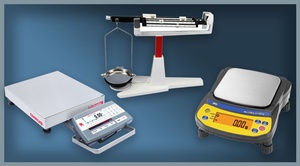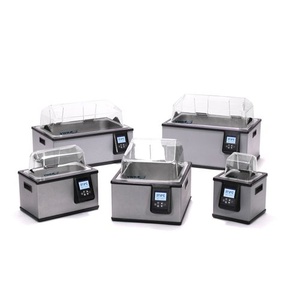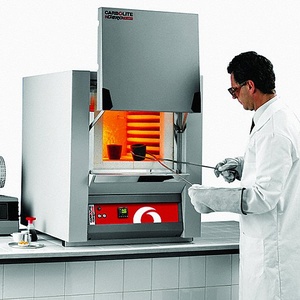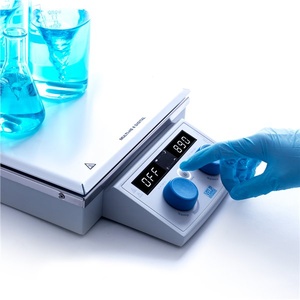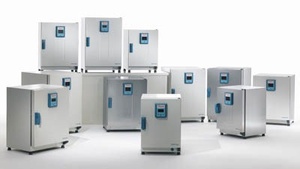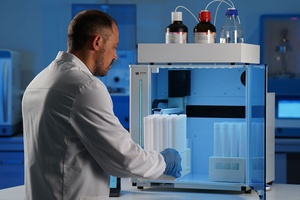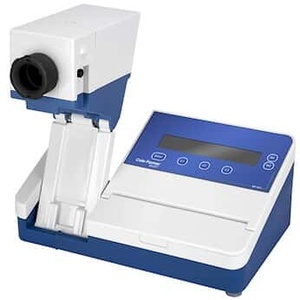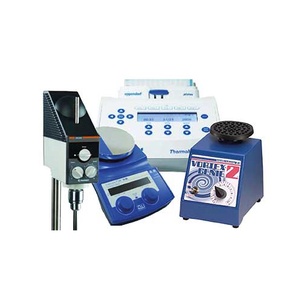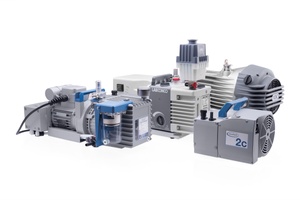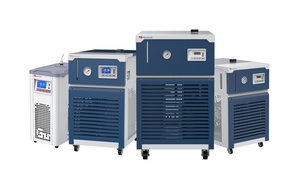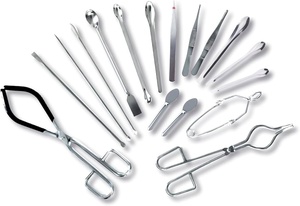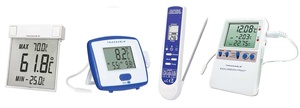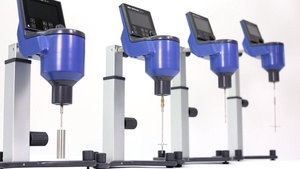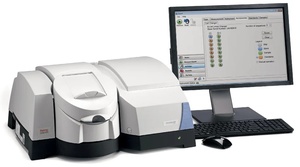Laboratory Equipment and Instruments
Furnaces are designed for a wide range of industrial and laboratory applications. A variety of energy-efficient models are available, including: muffle furnaces, split-hinge tube furnaces, box furnaces, and general-purpose tube furnaces. See also a range of thermocouples and furnace accessories. View More View Less
Used as an alternative to hotplates and Bunsen burners, heaters and heating mantles allow for direct contact with glassware without the fear of shattering because the heating element is typically insulated from the container. As a result, heaters and heating mantles can provide round bottom flasks with uniform heat distribution. Fabric heating mantles are foldable, allowing them to be used with numerous flask shapes and sizes, while rigid heating mantles are generally less prone to tearing or spill damage. The temperature for heaters and heating mantles is usually controlled by a rheostat, which makes maintaining temperature simpler. View More View Less
Hotplates and hotplate stirrers are benchtop laboratory tools that are used to heat evenly and mix various types of liquids and solutions. Conventional hotplates are used for heating only, while combination hotplate stirrers are able to simultaneously heat and mix. Infrared hotplates are an energy-efficient alternative to conventional and combination hotplate stirrers. Hotplate accessories such as temperature probes, external digital displays, and heating blocks can be combined with compatible hotplates. Available in various formats, our hotplates and hotplate stirrers offer the latest technology in single or multiple platforms and in both analogue and digital formats. A variety of capacities are available, ranging from a few milliliters up to 10 L or more, with a choice of top plate materials to fit application requirements. The combination of operational simplicity, reliable performance, and advanced safety makes choosing the perfect hotplate or hotplate stirrer easy. Generally, stand-alone benchtop appliances are used to heat glassware and its contents, however, if indirect heat is required, vessels may be suspended above the heat source using accessories such as tripods, retort stands, rods, etc. Hotplates and Hotplate Stirrer Features Conventional hotplates or specialty hotplates offer ceramic, aluminum, or stainless-steel top plate surfaces, with multiple plate shapes and dimensions. Combination stirring hotplates range from the most basic stirring design to explosion-proof models for hazardous lab applications, while providing precise control and repeatability to meet a variety of application needs. Larger capacity hotplates and hotplate stirrers are constructed for optimal strength, to withstand heavy loads, giving you the performance needed for large-scale applications. Feature Summary • Ceramic, aluminum or stainless-steel surfaces • Accommodate multiple vessels or slides • Analogue or digital control, can provide accurate monitoring and plate temperature • Typical operating temperatures range from 100°C to 750°C • Stirring speed ranges up to 2000 rpm A range of hotplate accessories is also available, such as stirrers and stir bars, retrievers, immersion probes (or temperature probes), and transparent shields. View More View Less
Systems, devices, and accessories designed for the extraction of compounds in various phases; available in a variety of materials and configurations. In the food industry, scientists use extraction systems to check for contaminants and other harmful substances in food samples to maintain food safety. What Are Extraction Systems Used for? Extraction systems are used to measure the fat content of foodstuffs or other materials. Although extractions can be performed manually, using extraction systems can reduce exposure to heat and toxic solvents like ethyl or petroleum ether. Soxhlet Extraction Systems The method was developed in 1879 by Franz von Soxhlet to extract lipids from solid materials. Typically, Soxhlet extractions are especially useful when the compound and the impurity have different solubilities in the solvent. The extractor can run by itself and efficiently uses only a small amount of recycled solvent to dissolve a large amount of material. A Soxhlet extractor consists of a percolator that circulates the solvent, a thick filter paper thimble that retains the solids, and a siphon to periodically empty the thimble. Goldfisch Extraction Systems This method is recognized by AOAC International (agricultural chemists) as an acceptable procedure for measuring fat and oil content. Extraction times can be reduced from 16 to approximately four hours with this reflux method. View More View Less
LabMart offers a wide range of laboratory mixers, shakers, and stirrers. These tools are essential for various lab processes, from simple stirring to more complex mixing and shaking tasks. They come in different designs, including vortex mixers, magnetic stirrers, orbital shakers, and more, catering to diverse scientific needs. View More View Less
Laboratory pumps are essential for transferring liquids, gases, or other substances in a controlled manual or automated manner. Types of pumps include vacuum, peristaltic, syringe, drum, hand vacuum, water sampling, and hose pumps. To support safe and effective pump operation, accessories and parts are readily available. Pump tubing in various sizes and materials is also available. Vacuum Pumps create and control vacuum conditions for processes such as rotary evaporation, freeze drying, filtration, drying and degassing as found in chemistry, biology, and material sciences labs. Peristaltic Pumps (also known as Hose or Squeeze Pumps) rely on rotation rollers or shoes to compress and relax tubing thus creating a wave-like motion that propels fluids. They are ideal for handling sensitive fluids as found in medical or pharmaceutical environments for drug delivery. Peristaltic pumps are also suited for any application requiring precise and contamination-free fluid transfer such as chromatography or bioreactors. Syringe Pumps utilize a motor-driven plunger within a syringe barrel to provide precise and controlled flow rates. These pumps are ideal for laboratory research and drug infusion, as well as other applications where small volumes and precise flow rates are critical. Drum Pumps handle liquids that are hazardous, viscous, or otherwise difficult to pour manually. Drum pumps typically consist of the pump unit attached to a long tube or hose that is inserted into the drum containing the liquid and are available in different configurations (such as rotary, piston, or electric) based on the type of liquid being transferred. Hand Vacuum Pumps create a vacuum to allow air or gas to be removed from a sealed container. These manual devices are hand-operated and are commonly used for fluid transfer and handling, siphoning, water aspirators for filtration, bleeding fluid lines, or checking for leaks. Water Sampling Pumps collect water samples from rivers, lakes, oceans, groundwater, wells, and other sources. They ensure that the collected sample is representative of the water source and is contaminant free. Common mechanisms used to draw sample water include peristaltic pumps, submersible pumps, or bladder pumps. Designed to meet EPA, NPDES guidelines. Pump Parts and Accessories ensure pumps maintain safe and efficient operations. Parts may include plunger assemblies, seals, gaskets, heads, valves, controllers, and vacuum traps. View More View Less
Recirculating chillers are used to cool laboratory equipment such as rotary evaporators. Chillers are available in a variety of cooling capacities, achievable temperature ranges, and reservoir volumes. Applications include separations, chemical reaction control, spectroscopy, and laboratory automation. View More View Less
LabMart supports you in every area of your facility. We offer you a comprehensive range of common lab essentials tools like spatulas, scissors, stir bars and rods, mortar and pestles, dissection tools and standard surgical instruments such as tweezers and forceps, knives, blades and scalpels to cell biology consumables such as syringes and needles, scrapers, spreaders, loops, needles and cell strainers. View More View Less
Browse the LabMart portfolio of educational and general-purpose thermometers, pH meters and timekeeping products. Choose from a range of high-quality, high-specification thermometers to support every aspect of your clinical projects, a variety of electrochemistry equipment to meet all the demands of your laboratory or classroom, and an array of precision clocks, stopwatches and digital timers to keep time wherever you are. View More View Less
Instruments used to measure the viscosity of a fluid; available in a variety of configurations. Viscometers or viscosimeters are important to many industries, including the adhesive, biotech, chemical, food, paint, petroleum, and pharmaceutical industries. What Is a Viscometer? Viscometers are instruments used to measure viscosity, the internal friction of the layers of a liquid in motion. An example is the slower flow of syrup from a container — syrup is more viscous than water. How Is Viscosity Measured? In general, viscometers move an object through a stationary fluid or move the fluid past a stationary object to measure the friction between the fluid and the object or surface. Viscometers measure using a single flow condition. What Are the Different Types of Viscometers? Glass capillary viscometers or Ostwald or Ubbelohde viscometers consist of a U-shaped glass tube held vertically in a controlled temperature bath. Liquid is drawn by suction into the upper bulb and allowed to flow down into the lower bulb. You calculate viscosity by measuring the amount of time it takes for the liquid to move between two marks. Falling ball viscometers measure the time it takes for a sphere of a known size and density to descend through a stationary liquid. This can be done electronically for opaque fluids. Rotational viscometers use the concept of torque to measure the effort required to turn a disk or bob in a fluid. Rotating bobs are more common, rotating cups reduce the likelihood of vortex formation, and "cone and plate" viscometers create a constant shear rate at any speed. View More View Less




 0
0
